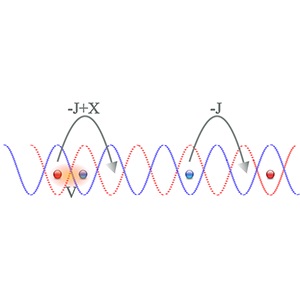08 June 2016
The field of ultra-cold gases in optical lattices is enabling the simulation of various well known quantum many body models underlying complex collective phenomena. These models are traditionally motivated by problems in such fields as condensed matter theory and high energy physics. However, the versatility of optical lattice setups often leads to the study of new, interesting models not considered before. This is the case in a new study conducted by researchers at ICFO in the research group led by ICREA Professor at ICFO Maciej Lewenstein in collaboration with researchers in Poznan and Krakow (PL), published in Physical Review Letters.
Researchers derive a new many body model describing the physics of two species of neutral ultra-cold fermions loaded onto a spin-dependent bipartite 1-dimensional lattice. The important property of the lattice is that the individual sublattices available for the hopping of each species are maximally separated with respect to each other – i.e. the troughs of one sublattice lie at the crests of the other sublattice. Apart from familiar hopping and interaction terms, the model describing this system is shown to have a naturally strong correlated tunneling amplitude spanning next nearest neighbors. The team provided a rather complete characterization of the properties of the studied system using a combination of analytical and numerical methods. In summary, the strong correlated hopping is determinant for producing a novel phase with a unique set of simultaneous properties: critical hole superconducting correlations which surprisingly are associated with non-local, long range string order.
From a fundamental point of view, a particularly appealing feature of the studied model is that it is exactly solvable for a particular set of parameters. Exactly solvable models of interacting particles are rare in the many body literature. They are significant due to the unambiguous complete information they yield about the properties of physical systems. Furthermore, they serve as references to test the validity of approximations that must be more generically used in studying many body problems. Notably, the exact solution provided by the researchers is independent of previous known solutions. It reveals the exotic superconductor phase mentioned above. Although, the exact solution works for a fixed set of parameters, the physical features it describes actually survive for a very wide range of system parameters, as shown by numerical means.
The separated lattice systems considered in the study are accessible in state-of-the-art ultra-cold gas experiments. This study has revealed new unexpected properties in such systems that enrich the spectrum of known features in one-dimensional physics that can be thereby observed. While sophisticated single particle phenomena, such as quantum walks, have already been experimentally demonstrated in these lattice configurations, truly many body features have not.
The results of this work may serve to motivate such investigations. The researchers have also provided an experimentally friendly protocol to almost arbitrarily tune the model parameters in such experiments.

Ultra-cold gases in optical lattices in PRL
Connections between superconducting correlations and string order for exploration in ultra-cold gas experiments.

Schematic of the optical lattice system with model parameters











